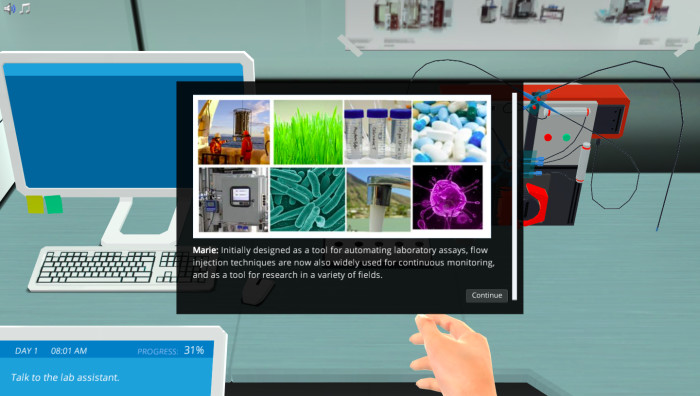
Flow injection analysis is an advanced analytical technique that facilitates high-throughput, automated measurement of chemical concentrations in samples. It finds a variety of applications in fields such as food and beverage analysis, pharmacology, clinical analysis, and environmental sciences.
Given its diverse utility, learning flow injection analysis can benefit many in academia and industry alike. However, the many hidden working parts, control parameters, and analysis methods that accompany this technique make it challenging to grasp. Here, we list five ways to teach flow injection analysis to your students in an engaging manner.
Using interactive models in education can make complex, layered topics modular and approachable. Such models can be quite useful in teaching sophisticated experimental techniques like flow injection analysis.
Take Labster’s flow injection analysis simulation, for example. In our simulation, students learn how to apply flow injection analysis to measure caffeine concentration in beverages. First, the interactive model takes the students on a tour of all the components of the flow injection analysis machine. They learn about the spectrophotometer, the injection pump, the mixing coil, and so on. The students then get to alter the different parameters that govern the machine’s performance to learn how to optimize it.

Games and activities can enliven the classroom with an immeasurable sense of fun and the accompaniment of collective learning. They make teaching less examination-oriented and more application-oriented.
The use of games and activities is even more fitting to teach flow injection analysis because the inventors of this machine used Lego blocks to make its first-ever version! Taking a page from their book, you can supplement your teaching by engaging your students in a Lego block activity. For example, divide them into several groups which can compete to build a model of the flow injection analysis machine.
Development and refinement of advanced technologies has completely changed the way educators envision the classroom experience. Animation, simulation, and virtual reality are just a few game-changers in the education sector. They help engage students’ imagination through audiovisual media and subsequently aid learning.
Labster’s flow injection analysis simulation, for example, uses 3D animation to explain the inner workings of the flow injection analysis machine. The students also interactively learn to utilize standard curves and absorbance graphs to calculate caffeine concentrations using flow injection analysis. Finally, they test a variety of samples for caffeine levels in a virtual lab – sodas, chocolates, energy drinks.

Discover Labster's flow injection analysis virtual lab today!
Students will be more curious about a study topic if it can assist them in building a successful career. Thus, educators can more effectively inspire their students to learn by discussing the professional aspects of the subject.
For example, tell your students how pharmacologists use flow injection analysis to detect and quantify active pharmaceutical ingredients. Talk to them about how food scientists apply this technique to assess the composition of foods and beverages. Discuss how environmental scientists leverage the high-throughput capability of flow injection analysis to quantify pollutant levels.
Students will be more motivated to learn obscure analytical techniques when they know their value in the real world. Building a connection with real-world applications helps them respect the subject matter and take it seriously.
Connect flow injection analysis to the many applications it has in industries that directly impact human lives. Tell your students how it helps quantify critical analytes in clinical blood and urine samples. Talk about its utility in measuring nutrient and contaminant concentrations in foods and beverages. Discuss the role that flow injection analysis plays in quality control in the pharmaceutical industry.
Flow injection analysis is an invaluable chemical analysis technique that demands the time and attention of all new trainees. The teaching methods we have discussed here can make flow injection analysis fun to learn and implement for your students.
Try our free 30-day All Access Educator's Pass today and teach with the Flow Injection Analysis simulation alongside 300+ other virtual labs!

Labster helps universities and high schools enhance student success in STEM.
Request DemoRequest a demo to discover how Labster helps high schools and universities enhance student success.
Request Demo